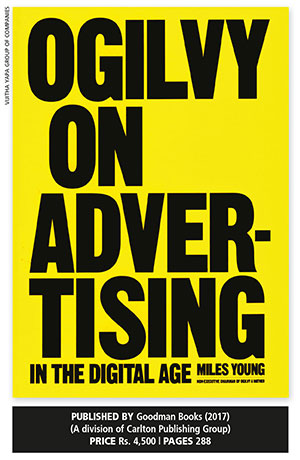BOOKRACK
By Vijitha Yapa
 Author, and former non-executive chairman of Ogilvy and Mather, Miles Young is blunt; the purpose of his book is to persuade people to read or reread Ogilvy on Advertising by David Ogilvy.
Author, and former non-executive chairman of Ogilvy and Mather, Miles Young is blunt; the purpose of his book is to persuade people to read or reread Ogilvy on Advertising by David Ogilvy.
The cast has changed, scenery is different, plumbing new; but the tragic and comic plots, subplots and counterplots of this business remain unchanged. The book Young refers to is considered essential reading for those in advertising and marketing, and he avers that “it is still pure, pure gold.”
But after reading Young’s own book, I found that the gloss seemed to be dimming on Ogilvy’s masterpiece.
Advertising has come of age and is being taken in a new direction. One of the best ads in Sri Lanka shows a little girl walking into a room where her architect father is designing a new building. She tells him not to create a room like the one he’s sitting in because she doesn’t want its owners to be so busy that they don’t have time for their children.
The advertiser is selling the services of a finance company, not building materials. Direct advertising has given way to a subtler method of unleashing a message that hits home hard.
Young asks what digital is: whether it is an evolution or a revolution. He reminds us of how in 1958, US President Dwight Eisenhower created the Advanced Research Projects Agency Network (ARPANET). Its goal was to create and ensure the survival of a communications network in the event of infrastructure being disabled following a nuclear strike.
Though a prime mover of that digital revolution was the creation of the internet, Young believes that the web is being riven by conflict. It’s being done by a combination of frustrated idealism and strongly vested interests.
The founders of the web thought they were ushering in something that was free and equal but the truth is that it is neither free nor equal. The uses of social media to influence elections are current issues; and President Maithripala Sirisena for one believes that he is one of the most affected victims of social media mud-slinging campaigns.
Young asserts that the advertising industry has had to fund much of the internet. He cites the example of Google where any search is paid for by advertising. He points out that Google rakes in an average profit of US$ 3.25 off every person on Earth and that this sum takes a quantum leap to US$ 7.25 if one considers only those who are online.
Whoever said that Google is free…?
As the internet becomes more commercial, it has evolved into a set of highly vested media interests. Young feels they have engaged in an orgy of wall building where the gardens behind the facades have become chargeable properties. “Entirely understandably, they have created the rhetoric of digital advertising that supports their agenda,” he notes.
He also talks about the disappearance of much of the ‘old media,’ adding that there are many novel aspects to the digital revolution. There are two contrasts between the ‘digital Taliban’ of John Hegarty and the latter-day Luddites. The former, the author of Hegarty on Advertising, is known for many remarkable sayings.
“The function of advertising is simply to promote and sustain competitive advantage for brands” is one such claim. Hegarty describes the first lesson of branding – memorability. It’s very difficult to buy into something you can’t remember.
But the quote I like best is: “Better to be known for something than be forgotten for nothing.” And here’s another gem: “Always remember – a brand is the most valuable piece of real estate in the world; a corner of someone’s mind.”
The Luddites were a group of textile workers during the Industrial Revolution who believed that machines would cause workers’ wages to decrease. Their protests resulted in the burning of a number of factories because they did not want change.
Some predict the death of television but the author cites seven points to prove that TV isn’t dead. The one I like most is that TV is the best vehicle for communicating emotion, which brand platforms require. The 7.30-10 p.m. peak time slot in Sri Lanka attracts the highest number of viewers and programmes include many teledramas where emotion is often the central theme.
An advertisement from 1909 reproduced as an illustration has an interesting tag line: “Even the best advertisement in the world is the worst investment in the world – until it is seen.”
Such illustrations make this book a worthwhile investment because these and the attendant boxes are worth a second look. It’s not only those involved in advertising who will find this book useful but marketers and consumers as well.




